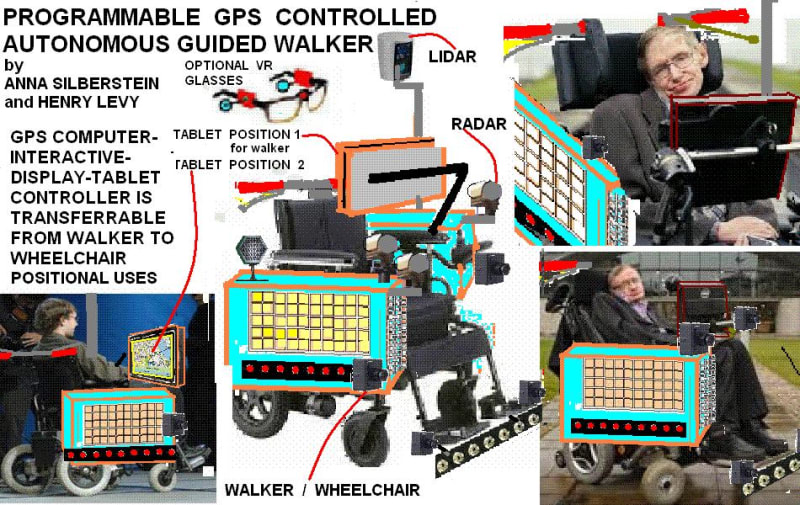The invention of the Smart, Servo Driven, Talking, "Lead Me Where I Want to Go," GPS Controlled GUIDED WALKER, (whose controller is transferable to a“Take Me Where I Want to Go,” GPS Controlled Guided Wheelchair, or cart), is similar to Stanford University's autonomous vehicle, Stanley, Google's driverless car, and Tesla's self driving car.
The programmable GUIDED WALKER and wheelchair can either lead a walking person or carry a physically challenged person, blind woman, elderly man, handicapped girl, mentally challenged boy, alzheimers patient, autistic child, or brain injured wounded warrior, to his or her destination and back to home autonomously.
This battery powered self propelled WALKER (or wheelchair) has at least one steering servo motor, and at least one propulsion servo motor. The WALKER’S GPS computer-interactive-display-tablet controller means (transferable to his wheelchair) provides geodetic positioning, navigational data, street, terrain, & arial view, maps, computer servo control of autopilot steering function, propulsion, and collision avoidance control of both guided systems. Hand brakes, joystick, speech recognition control, released hands, and/or touching the tablet overrides and stops all movement. A linked virtual reality audio visual glasses display system is optional. Preset, and variable motor speed controls, as well as, pulling force limitation is provided. Existent front and side mounted ultrasonic emitter/detector arrays, RADAR, and LIDAR sense obstacles for collision avoidance maneuvers. Assisting the self-leading feature of the GUIDED WALKER are audio and visual alerts, such as announcements; "turn left here now, downhill grade, watch out curb ahead, curb, beep, beep, beep, and stop now, car approaching from right, backup, etc." A talking range finder, depth ahead finder, and existent talking object, sign, & facial recognition systems are included. Artificial intelligence and fuzzy logic assists navigation, display, and control of both systems.
Pot holes and foot obstructions are recognized by stereoscopic cameras, ultrasonics, and retro reflective lasers. Snow and rain should be avoided.
Programming a route from a person’s home to his school, then to the library, to the grocery, and then back home greatly assists an individual by leading or carrying him to his destinations.
A user or his caretaker can preprogram the guidance system by voice, text, joystick, or GUI touch. The system user can listen to an ongoing narrative of his environment. Well known technologies of built-in telephone, internet access, camera, radio, compass, and remote control, should be included.
Walker features are well known individually in the prior art.
The distinguishing novel features of the GUIDED WALKER are the programably guided motorized leading/pulling function, the new combination of control functions of and for a walker, the structural novelty of a walker with a tranferable GPS display controller tablet mounted in front of the walker-user which controls the servo self propulsion, servo autonomous self-steering, and the combinational use of VR audio visual glasses . The similarly controlled, GPS guided, motorized wheelchair is even more useful to a larger population. Chair and walker is really one. “Wheelchair, take me where I wanna go, to Ray Kurtzweil’s laboratoiry.”
Like this entry?
-
About the Entrant
- Name:Henry Levy
- Type of entry:teamTeam members:ANNA SILBERSTEIN
HENRY LEVY - Software used for this entry:MICROSOFT PAINT
- Patent status:none

